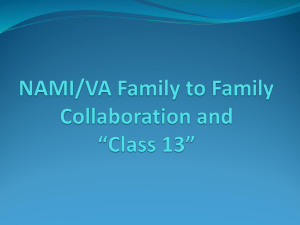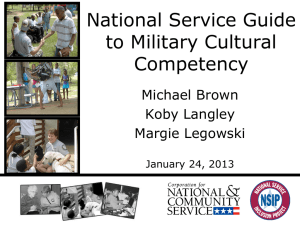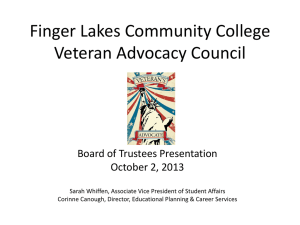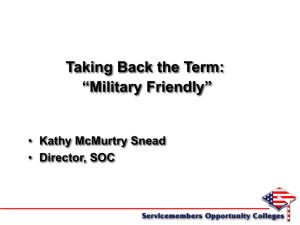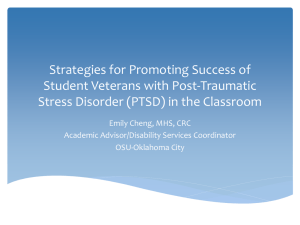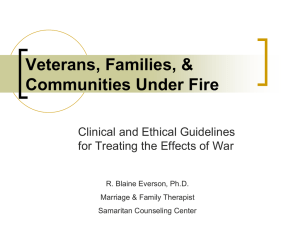The Unique Needs of Veterans at the End of Life
advertisement
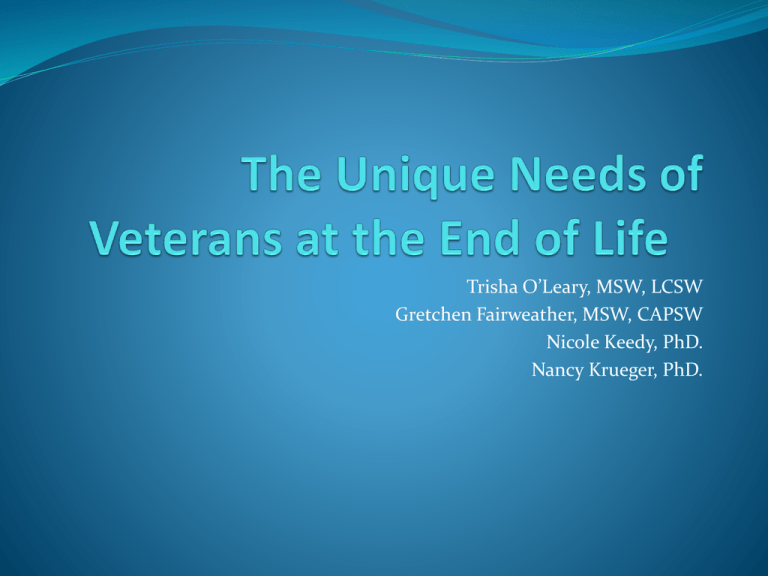
Trisha O’Leary, MSW, LCSW Gretchen Fairweather, MSW, CAPSW Nicole Keedy, PhD. Nancy Krueger, PhD. Presentation Overview VA benefits: Resources, access, and eligibility Effects of military culture and combat on the end of life experience Mental health and PTSD in Veterans at the end of life Access to the VA It is important to ask each hospice patient if they are a veteran, as this will have an impact on the care plan. If the patient is a veteran, the next step would be to find out the veteran’s enrollment status in the VA. In order for a veteran to receive hospice benefits, he/she must be “in the system.” Are you enrolled with the VA? If yes, then ask what clinic they are in and who their Primary Care MD is. The VA has divided the primary care clinics by color. Each clinic has a social worker assigned to it. This clinic would be a link to additional resources, if needed by the veteran. The clinic could also assist with getting into a VA contract nursing home or the palliative care unit. If not enrolled then….. If the veteran has not enrolled in the VA system, then it would be appropriate to ask the veteran if he would like to enroll. In order to get “in the system” the veteran must complete form 10-10EZR, which is located on the internet and provide a copy of his DD214. The DD214 is a one page form that describes when the veteran served, dates of service and type of discharge. Sometimes these are stored in county courthouses, or the VA could try to obtain a copy. (https://www.1010ez.med.va.gov/sec/vha/1010ez/) Eligibility for the VA Not all veterans are eligible for care. The admissions department determines eligibility based on income, assets, service time and current medical expenses. Veterans are always encouraged to apply. The quicker we can get the needed forms, the sooner the veteran can get registered. Options available to enrolled Veterans The palliative care unit VA contract nursing home care Home hospice care Continued “aggressive treatments” Burial benefits The Palliative Care Unit This is a 24 bed inpatient unit that serves veterans with a limited life expectancy, days to weeks, and those needing radiation/chemo treatments. This is a free benefit to the veteran Admission hours are Monday-Friday, 8:00AM-3:30 PM Cannot guarantee admission same day as veteran is referred Contact the palliative care unit directly for admission. #414-384-2000 ext. 46742 or 42483 VA Contract Nursing Homes VA contracts with several skilled nursing facilities in the area. Veterans in need of hospice care, but can no longer reside at home are eligible for care in a contract home with VA paying the room and board. If VA was paying the hospice care, this would continue in the nursing home. Contact primary care clinic for assistance with this process or the palliative care unit. Home Hospice Care VA does not provide home hospice care, we depend on community agencies to provide this. The VA will pay for this care, if there is a provider agreement in place. If the veteran chooses to use another payer source (Medicare/Medicaid) then the requirement for a provider agreement is not needed. VA will pay the hospice agency the Medicare per diem rate. Continuation of Aggressive Treatment Veterans are not always ready to terminate treatment completely and not all hospices offer open access care. Since the VA does not bill Medicare, the veteran can continue to come to the VA for what would be considered “aggressive treatment,” if part of the care plan. Some examples include: blood transfusions, palliative radiation treatment and oral chemo. Burial Benefits These are dependent upon veteran’s location of death and if the VA was paying for the hospice. Always encourage family to call the VA Regional Office at #1-800-827-1000 to learn about death/burial benefits. IS THE END OF LIFE JOURNEY DIFFERENT FOR VETS? Gretchen Fairweather, CAPSW 1800 vets die each day in U.S. Only 4% die in VA facilities Greatest percentage of vets will be served by community hospice Need for collaboration between community hospice agencies and VA (statistics retrieved from www4.va.gov/oaa/archive/hvp_toolkit3.pdf) What makes end of life (EOL) needs of vets different? Military culture promotes stoicism Showing fear or pain considered weakness Basic training often demoralizing Vets may have trust or guilt issues High instance of substance abuse (Grassman, D. L., 2009) Combat Experience –Biggest Influence Veterans may have complex needs resulting from combat or Prisoner of War experience May have already faced death as dramatic event Coping with unresolved grief or guilt May have survivor guilt – “Why did my buddy die and I didn’t? I should have saved him” Perhaps witnessed traumatic events causing PTSD Different War – Different Memories Veterans of different wars had different experiences Sense of important mission or purpose Geography and climate effects Style of engagement: Who was the enemy? War’s result – Was there a clear victory? Support from those back home Reception upon return Each war had a unique culture which influenced returning veterans WWII had a clear mission 1941-1945 Supported by virtually everyone Fought in several countries in extreme climates and circumstances American public shielded from much of the horror Soldiers came home to hero’s welcome Nation wanted stories of victory – soldiers needed to give voice to atrocities of war Korean War 1950-1953 Military conflict often called “The Forgotten War” Soldiers fought in extreme weather conditions – frostbite was prevalent Ended in stalemate Soldier’s efforts minimized, traumas ignored Vietnam 1964-1975 Unpopular war Extensive TV coverage of brutality of war Anti-war sentiments back home Draftees and enlistees turned into cynics by uncertainty of mission Guerrilla war tacticsenemy could be anyone A war without a victory Soldiers felt disrespected, shamed, disregarded Vietnam (cont.) Soldiers buried their stories Emotional baggage PTSD Survivor guilt Depression Suicidal ideation Effects of Agent Orange Malaria Desert Shield/Desert Storm OEF/OIF Hospices may be treating soldiers of recent wars Recently acknowledged that some veterans serving in the military have experienced MST (Military Sexual Trauma) Is now a recognized treatment focus as well as results of PTSD and TBI (Traumatic Brain Injury) Many women now serving in combat zones will have own special needs at end of life Understanding a combat veteran facing EOL Important for those serving vets to have appreciation and understanding of experiences known only to a combat soldier VA is in unique position to assist hospices in developing best-practice strategies to help vets on their final journeys Nancy Krueger, Ph.D. Nicole H. Keedy, Ph.D. OBJECTIVES Overview of how the military shapes attitudes about death and dying Understand special mental health needs of Veterans at end of life Learn strategies to help the veteran cope at end of life with psychological issues, especially PTSD Special EOL Considerations in Veterans Suicidality Highest prevalence in White, older, males Also higher prevalence in Veterans than non-Veterans Firearms Increased comfort and knowledge about them Potential lethal means for suicide Locks (available to Veterans through the VA) Posttraumatic Stress Disorder Prevalence Up to 84% of people experience trauma in their life and it is thought that 25% of these individuals experience PTSD (Feldman & Periyakoil, 2006) Some people who did not previously have symptoms may experience delayed onset at the end of life The end of life experience may trigger emotions and memories from their trauma Trauma Combat is one type of trauma Other types include Sexual assault (and military sexual trauma) Motor vehicle accidents Seeing someone harmed Other threats to oneself or others Military combat may be different than other traumas Repeated trauma One person may be both victim and perpetrator Potential PTSD Triggers at EOL Pain Decreased functional capacity Helplessness Fear and Anxiety Medication side-effects In some people who are accustomed to feeling tense, the sensation of relaxation may paradoxically create discomfort and anxiety PTSD - Assessment • PTSD diagnoses requires the experience of a traumatic event in addition to symptoms that can be described in three clusters: – Re-experiencing symptoms (repetitive disturbing memories, nightmares, and hallucination-like flashbacks) – Avoidance symptoms (attempts to avoid reminders of trauma—objects, places, people) – Hyperarousal symptoms (hypervigilance, irritability, exaggerated startle response, and insomnia) American Psychiatric Association (DSM-IV-TR), 2000 PTSD - Assessment • Other conditions have similar features: – Delirium • • • • • • Paranoia Suspicion Agitation Fear Hallucinations Confrontation – Anxiety • Agitation • Worry Potential effects of PTSD Difficulty sleeping due to nightmares Disturbing thoughts and memories that patient has difficulty avoiding Mild paranoia Vivid hallucinations Intense anxiety (Fight/Flight/Freeze) alternating with "no feelings at all" (emotional numbing). Distrust of others Potential Effects of PTSD • Threat to life can mimic the original trauma, and • • • • exacerbate previously mild symptoms The normal process of life review can lead to intense anxiety, sadness, guilt, anger Avoidance as a coping mechanism may lead to poor medical adherence or poor communication with medical staff Distrust in authority can lead to excessive questioning of providers' actions and refusal of care Patients with PTSD may lack caregivers because of a history of social isolation and avoidance Family Dynamics of PTSD Family reactions are complex and each situation is unique Emotional numbing may create distance with loved ones Veterans with PTSD may be irritable much of the time Veterans may engage in routines or behaviors such as “checking the perimeter” and avoiding public places Veterans may attempt to control family and situations to the extent of control required in battle Treatment of PTSD Drugs to reduce intensity of symptoms (TCA, SSRI, Benzos) Psychotherapy (often not possible during brief admissions) Group therapy Psychosocial symptom management (helpful for brief admissions) Psychosocial Management of PTSD Adopt a patient-centered approach Egalitarian communication style despite patient's hostility and avoidance Staff must increase awareness of their own reactions to patient. Staff may feel: Sympathy for patient's suffering Anger at patient's behavior Guilt or sense of responsibility for patient’s distress Psychosocial Management of PTSD • Consider ways in which one's approach with the patient may trigger fear, startle, avoidance, or other reactions, and work toward altering one's approach – Ask patient about behaviors that may trigger PTSD • Shouting • Pointing • Touching • Entering room unannounced • Ordering them what to do rather than providing options – Ask patient about behaviors that may help • Providing nightlight • Awaken patients by stating their name rather than touching • Increase privacy • Normalize the patient’s experience – some Veterans may not know about PTSD Possible Questions In what branch of the military did you serve? When and where did you serve? Did you see combat, enemy fire, or casualties? Were you wounded or hospitalized? Do you have nightmares or feel like you are back in combat sometimes? Do you try to avoid thinking about it? Are you easily startled or constantly on guard? Possible Responses Listen patiently and warmly, and allow them to stop when they are ready Avoid attempts to comfort that actually serve to stifle the topic (“It’s ok,” “Don’t cry,” “That was a long time ago,” etc.) Inform them that it is very normal to have these memories and to feel distressed by them, especially near the EOL “Is there anyone to whom you would like to speak about these concerns? A chaplain? A social worker?” Possible Responses, cont. Signs a Veteran may be having a flashback Behaving as if in warfare Looking extremely fearful Freezing and staring into space Making statements such as “look out” or “I see the enemy” Engage in verbal “grounding,” while maintaining physical space for safety “Mr. _____, we’re in your bedroom, in your home in Milwaukee, and my name is _____.” Questions? References and Resources American Psychiatric Association. (2000). Diagnostic and Statistical Manual of Mental Disorders, (Revised 4th ed.). Washington, DC: Author. Feldman D.B., &Periyakoil, V.S. (2006). Posttraumatic stress disorder at the end of life. Journal of Palliative Medicine, 9, 213-218. Grassman, D.L., (2009). Peace at last: Stories of hope and healing for veterans and families. Vandemere Press: St. Petersburg, FL http://en.wikipedia.org/wiki/Korean_War http://www4.va.gov/oaa/archive/hvp_toolkit3.pdf Seahorn, J. J., & Seahorn, A.H. (2008). Tears of a Warrior: A Family's Story of Combat and Living with PTSD. Fort Collins, CO: Team Pursuits. http://www.tearsofawarrior.com
